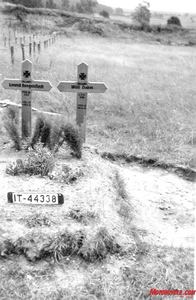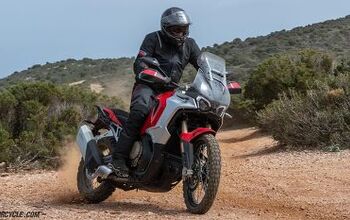Bikes of the Blitzkrieg
Somewhere in the vastness of Eastern Russia lay the graves of two German soldiers.
The photograph seen below, perhaps taken by a comrade in arms, identifies them as members of a motorcycle rifle troop thanks to the license plate left on the grave along with the carefully placed wildflowers. The license plate was once attached to the front fender of their Zundapp, NSU or BMW motorcycle.
We can read the soldiers' names although the original photo is now more than 65 years old. It tells us that two members of the Wehrmacht, the German military machine that blitzkrieged across Europe and into Soviet Russia, stopped here and went no further on June 18, 1942, the fateful moment when the German army reached Stalingrad, the beginning of the end for the Third Reich.
Motorcycles have been going to war as long as there have motorcycles around to go to war. American Harley-Davidson and Indian; British Triumph, BSA Matchless and Norton; Italian Moto Guzzi and Gilera; French Terot and Gnome Rhone; Belgian FN and Gillet. If you had a war to go to, motorcycles would get you there, oftentimes faster and through terrain inaccessible to other vehicles. The German military was the largest employers of motorcycles during World War II 1939-45. In addition, as German forces swept across conquered lands, they acquired a wide array of British, French and Belgian machines, painted them Wehrmacht gray and sent them into battle. German military motorcyclists played an important role either in solo courier or scouting capacity, as teams of tank hunters or in divisions of rifle troops.
What did the German soldier think of their warhorses? One NSU rider wrote back to the company the following words of praise, often echoed by his comrades. The following quote is contained in two excellent resource books titled "Motorcycles of the Wehrmacht" and "German Military Motorcycles" by Horst Hinrichsen (Schiffer Military History series).
"On September 21, it has been five years since I bought it new at your Stuttgart branch, where I worked as a mechanic since August 1939. Since the end of August I have been in Wehrmacht service with the motorcycle, which I myself have always driven since then. During the four years of my private driving, the machine always functioned to my complete satisfaction, as it has now, since I have been drafted. In this year I have driven it 20,000 km, at first in the Polish
This letter was penned in the early part of the war when Germany seemed invincible. There is no word if the satisfied customer was ever able to claim his beloved motorcycle.
On June 22, 1941 Germany launched its Operation Barbarossa, the 3-million-man invasion of the Soviet Union. During the campaigns that followed they served a variety of functions including chauffeur service for officers, delivering dispatches, even hot meals, as scouting patrols, as point vehicles taking the brunt of battle, sometimes as specially equipped tank destroyers. As with all motorcyclists, there was a kinship among these soldiers who called themselves "kradmelder." They rode exposed without the armor plating of the Panzers, without the safety of hundreds of foot soldiers beside them. Moving targets as it were. Sniper magnets. And then there were mine fields, artillery fire, and strafing aircraft to contend with.
The other enemy was the Russian weather. By autumn the roads had turned into nearly impassable bogs, the fields over which the motorcycles traveled turning in to "seas of jelly three feet more deep." Pack horses sank to the bellies, boots were sucked off the soldiers' feet. Motorized forces that had once traveled over 70 miles in a day now were lucky to make 10. By winter, temperatures fell to -40 degrees, engine oil and exposed soldiers froze solid.
"By war's end, many if not most of the motorcycles, along with their riders, never returned home."
Many of the images seen here were snapped on the Russian front aka the Eastern Front, or the Ost as the Germans called it. It was a term that later became synonymous with almost certain oblivion. The German war machine ground to a halt at Stalingrad and never recovered, the tide of battle turning against the Thousand Year Reich that would last but 12 years.
By war's end, many if not most of the motorcycles, along with their riders, never returned home. Some 13,000,000 Germans who went to war never returned home. The Russians lost some 30 million.
We can look at the photographs and try to imagine what it was like. But we can't. We can, however, observe that motorcycles have survived Depressions, global wars, and bad press, but still keep on rolling. Maybe it really does have to do with freedom, the essence of motorcycling about which all bikers can agree.
However in this case the individuals who sent out these motorcycles were intent on the opposite, the denying of freedom. Ultimately they failed, but at an unimaginable cost.
Let's leave the final word with a portion of a motorcyclist's poem called "The Hat, The Table and the Broom."
In the East the cyclist's lot was not light
And I often believe the prophet was right,
When I saw cyclist engulfed in the flood,
Trying to free his machine from the mud.
And when I saw the man around Riga again,
A frustrated cyclist, with puzzled brain,
Stood there with a cycle that just wouldn't start
A load on his mind and a pain in his heart.
The man said: "Your faith is delusion, of course.
You can only depend on the great iron horse,
Or a horse with a saddle, if not trains around,
In no other way can you cover this ground.
The Machines
The German's mechanized lightning war (“blitzkrieg”) required machines of high caliber in more ways than one. Although horses and even bicycles carried battalions of combatants, as did trucks and tracked vehicles, motorcycles led the way. Purpose-made BMW and Zundapp military bikes as well as civilian models made by NSU and DKW and a host of other makes that "served" either by contract or requisition.
For heavy-duty sidecar use the German military relied upon the Zundapp KS750 and the BMW R75, both companies also making their own sidecars although those built by Stoye, Royal and Steib were also employed. Next in line were the motorcycles manufactured by DKW and NSU. Non-German motorcycles, bought under license, included Triumph, more than 12,000 250cc units built in Nuremburg, also home to Steib sidecars of the era, and later site of the famous war crimes trials. (By comparison some 60 years later, about 9,000 Triumphs were sold in the U.S. in 2004.)
Frontline German Motorcycles By 1938 some 200,000 motorcycles were produced in Germany and the adjacent areas it had annexed (aka Greater Germany or the Reich). The principal bikes included BMW, DKW, NSU, Triumph (under German license),Victoria and Zundapp. (By comparison, BMW posted 93,836 units sold for 2004.)
BMW
The BMW motorcycle, first launched in 1923, had broken the motorcycle speed record with a supercharged 750 in 1937, reaching 173.68 mph. In June 1939, three months prior to the start of WWII, German rider George Meier won the famous British Isle of Man TT, the first for a foreign rider on a foreign bike. In addition to the vaunted 750cc R75, BMW also supplied the military more than 36,000 side-valve R12 BMWs.
The Wehrmacht utilized the followed models: R4, R12, R23, R35 and R75.
R-75 Sidecar
Also known as the "Type Russia," it was literally unstoppable until it encountered the snow drifts outside Stalingrad. Designed between 1939-1941, the tank-tough R75 with its crankshaft-driven sidecar proved itself to a major success, boasting 52 miles to the U.S. gallon, a range of 225 miles and a carrying capacity of over 1,000 lbs., about equal to its own 929-lb weight.
Specifications included a 745cc air-cooled four-stroke OHV twin-cylinder engine that produced 26 hp at 4000 rpm. An 8-speed transmission had two reverse gears as well. Top speed was a reported 60 mph. The shaft final drive featured a split-tongue differential, 2/3rds going to the bike, 1/3 to the sidecar. But it arrived too late in the war and in too small numbers (16,500) to affect the final outcome, its factory in Eisenach destroyed in 1944 by Allied bombing. Today it is a most sought-after collectible fetching as much as $45,000.
DKWEstablished in Zschopau, near the city of Chemnintz in 1919 by a Danish entrepreneur, it became the largest brand not only in the German Reich but in the world. In 1932 the company merged with Auto Union, composed of DKW, Audi, Horch and Wanderer car makers. Post-war DKW later became MZ, then more recently Hercules while retaining the DKW name because of its reputation. German military models included the RT125 and NZ350.
NSU
The marque's name was derived from the city of its manufacture, Neckarlsum, and thus the letters NSU. The company first produced knitting machines in early-Industrial Age 1873, then moved on to bicycles and automobiles as well as V-Twin motorcycles. NSU built prototypes that eventually appeared as the Volkswagen, Hitler's "people's car." German military models included the Pony 100, 201 ZDB, 251 OSL, 351 OSL, 501 OSL, 601 OSL, 501 TS and 601 TS.
Victoria:
Victoria started out as bicycle maker in 1886, introducing their first motorcycle in 1899. The Nuremberg facility later added an engine factory in Munich, the engine designed by an ex-BMW engineer. In 1926 their supercharged racer broke the speed record with 104 mph. In the 1930s they began producing two- and four-stroke machines from 98cc to 248cc. German military units included the KR 35 WH and K 6.
Zundapp
Established in 1917 to make fuses for artillery guns during the First World War, Zundapp began building high quality bikes in 1919, both two- and four-strokes. By 1933 the company had produced 100,000 motorcycles. Between 1938-41, over 18,000 Zundapp 600cc KS W sidecar rigs were built for German military use. The best known Zundapp was the KS 750 flat-Twin built exclusively for the army. German military models included the DB 200, K 500W, KS 600 W, K 800 W, and KS 750.
The Vaunted KS 750
Housed in a pressed-steel frame, the 751cc transverse-Twin produced the same 26 hp as its BMW counterpart and featured eight gears, divided in four forward, four reverse, the side car also driven. The KS 750 went into production in 1940 with approx. 18,695 units built. Weight was 920 lbs. with a top speed of about 60 mph. It was frequently equipped with the m34 machinegun attached to the sidecar.
Joseph Stalin himself established IMZ-Ural in 1941 specifically to build copies of the BMW R75 as combat vehicles for the Red Army. Ultimately 10,000 of the M-72s went to war. They were built in Siberia in a factory east of the Urals and thus their name and still home to modern Urals. In the mid-1950s civilian Urals went into production and in 1993 they were introduced into the USA. At last estimate there are something like 3,000,000 of them on, and off, the road mostly in Eastern Europe and Russia. The new Ural Russian Motorcycles have taken the '40s BMW/Russian clone and updated it both mechanically and cosmetically.
The Chinese Communists, acquiring Russian copies of German WWII BMW's, came up with their own variations including the Changjiang (1970 model seen here) as used by the Chinese Army. California-based R.C. Marketing is now importing and selling these bikes in the U.S.
More by Paul Garson









































Comments
Join the conversation